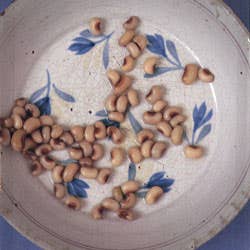
Know Your Peas
Peas of the green (or snow or sugar snap) type are one thing. But what about pigeon peas, chickpeas, asparagus peas, cowpeas, and black-eyed peas—not to mention peanuts?
Peas of the green (or snow or sugar snap) type are one thing. But what about pigeon peas, chickpeas, asparagus peas, cowpeas, and black-eyed peas—not to mention peanuts?
Well, to begin with, of course, peanuts are neither peas nor nuts but the seeds of an American leguminous annual that grows mostly at ballparks and in circus tents.
Pigeon peas are a legume of African origin, now especially popular in Jamaica.
Chickpeas, also known as garbanzos, are a legume of Asian origin that grows one or two to the papery little pod. They are the quintessential Mediterranean poor people's food, easy to cultivate and nutritious; Americans eat them in coffee-shop salads.
Asparagus peas, which neither look nor taste like asparagus, are Mediterranean born; also called the goa, manila, princess, or winged bean, they are eaten pod and all.
The cowpea is the black-eyed pea (Vigna unguiculata) under another name, and the black-eyed pea is one of the world's great vegetables—a distinctively flavored, pleasantly earthy-tasting, kidney-shaped legume, pale green or faint brown in color, with a trademark dark brown "eye". Originally from Africa, black-eyed peas have become a staple of the cooking of the American South—and are found in little pockets of culinary good sense in Spain and Italy. Eat them on New Year's Day for good luck all year long.
Keep Reading
Continue to Next Story










